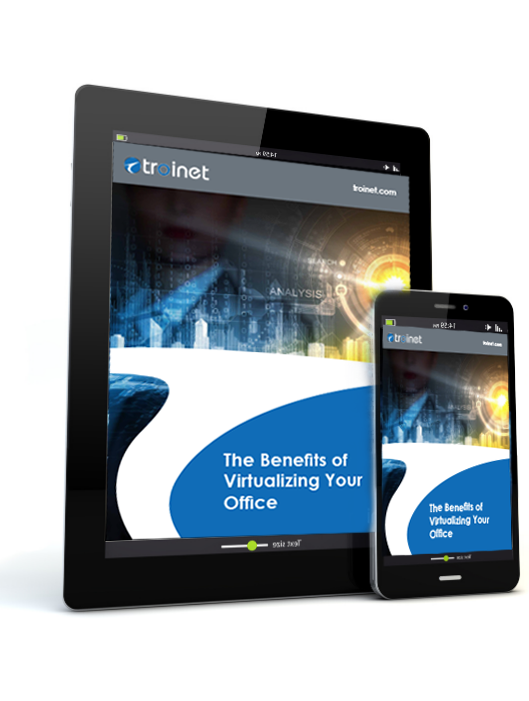Office Virtualization lets you remotely use your business resources and services at a fraction of the price of traditional offices. With the freedom to work from anywhere in the world, you can easily manage your business affairs from one convenient location without upgrading your hardware or changing your existing IT setup. Office virtualization is the office of the future, today.

We help organizations establish and maintain virtual desktop environments to overcome the expenses and complexities of hardware-based computing. After 20 years as an IT firm, we employ a strategic approach to deploying our technology, empowering customers to choose the best solution at a price that meets their unique needs.
- Businesses seeking to reduce office space needs
- Reduce operating expenses without reducing productivity
- Combine the best attributes of coworking environments, business centers, and traditional office spaces
Whitepaper: How virtualization can advance your business.
Benefits
Virtualization has many benefits but among the top are cost-savings, enhanced work capabilities, increased productivity, and greater peace of mind and security. It keeps your business moving.
Peace of Mind
Stable systems, less worry. Operate from wherever you want, whenever you want. You can do more while waiting hours in the airport. Your vacation won’t be bothered because of quick access. No need to be tied to your desk. No need to rush to the office when needed. Avoid constraints of traditional office.
Lower Expenses
Office virtualization is a method of reducing overhead costs. Rather than purchasing expensive computers for each employee, one computer can be shared by multiple employees, with software designed to partition it into multiple “virtual” computers. It is particularly useful when many of the employees are not in the office at the same time. Office virtualization can reduce overhead costs by up to 50%.
Maximize the Use of Your Physical Space
Enjoy More Flexibility with Your Work Location
Enable your Sales Teams with their Sales Presentation
Increase your Expansion Capacity
Eliminate Unauthorized Access to your Sensitive Files
Learn more about the benefits of virtual desktops.
Key Features
Advanced infrastructure and skilled staff at a fraction of a cost.
Working from home has become a mainstream idea only recently. Before the advent of remote desktops and virtual desktops, those who wanted to telecommute had to work with limited or outdated hardware and software.
To avoid these limitations, professionals need to travel to their office just to access the office resources and services of skilled staff. Office Virtualization is changing this. By providing employees with access to their workstations from any location, virtual desktops are making working remotely more appealing.
Virtualized front office, back office and accounting
Digitalize your business! You can virtualize all or any business processes (accounting, sales, billing, payroll, inventory management, project management) with the online solutions Troinet offers.
Troinet provides an integrated solution for the virtualization of the front office, back office, and accounting using virtual machines hosted remotely on state-of-the-art data centers with failover mechanisms and Secure Sockets Layer technology, which guarantees the security of your information.
For businesses, virtualization brings flexibility and efficiency by allowing the use of a single computer to serve many different functions. In doing so, it also improves security by reducing access to shared servers and limiting server downtime by allowing different areas of a company to access what they need when they need it.
Stay in control: Keep your data within your own servers
Troinet’s unique approach to data protection can be fully or semi-automated. It’s like getting on your computer and having your backup, deduplication, replication, and mobility roll out– on its own without any effort from you. That means less time spent managing backups and more time doing what you do best.
Multiple operating systems and accounts
Data restore points
Virtualization software present a virtual machine to the operating system, which in turn presents it to the applications. If you make a mistake, you can go back to a previous snapshot and try again from there. The idea of automatic Data Restore Points is not new — it’s been available in some backup systems for decades — but virtualization makes it more convenient and reliable.
We used to take snapshots manually, with a special command. Now we can do it automatically whenever or as programmed.
One of the things customers like about virtualization is the ease of creating an automatic Data Restore Point. They run Windows on their main computer, and it has a feature called System Restore that periodically saves a snapshot of the system in case something goes wrong. The problem with System Restore is that it’s just one snapshot. If the same thing goes wrong again, you have to take all the same steps you did before.
They never found it easy to go back to an earlier snapshot without wiping out everything since then. (The option doesn’t even appear in the menu if you aren’t booted into Safe Mode.) So if working on something important, many do prefer to use Virtual PC or VMware Player, which lets users create restore points at any time.
Ubiquitous access
The important thing about virtualization is that it enables ubiquitous access. It doesn’t matter where the physical information is; all that matters is that everyone who needs it has access to the information or a document, any time they need it.
Dr. De Lacy Davis, Executive Director of FSO Union, shares how their organization benefited from Troinet IT support.
Documentation
Virtualization is the process of establishing the virtual version—something that appears to be real, but isn’t—of something like a network, a server, a storage device, an operating system, and the like.
It is a technique for running software without installing it. A piece of software that has been virtualized is called a virtual machine, or VM.
[Office] or “Workspace virtualization is the ability to abstract a user’s workflow and untie it from the constraints of the physical desktop,” said Joe Stone, network engineer at Boice.net, a networking and collaboration solutions provider.
With Office Virtualization, a user can access his or her applications and data anywhere because it is no longer dependent on a single work station or operating system.
Technologies Related to Virtualization
- Windows Virtual Desktop
- Oracle VirtualBox
- VMWare Fushion
- Virtual Machine
- Parallels Desktop
- Hypervisor
- VMWare
Virtualization Concepts
Any endpoint device can access a virtual desktop from anywhere – it could be a tablet, smartphone, or another PC. Use case scenarios:
- Team members access their files and applications using any endpoint device with an internet connection.
- One centralized location stores the data for centralized deployment, maintenance, and management.
- Employees don’t need to install applications in their devices repeatedly when they use a new device. They can access via the virtual desktop.
- Businesses can recover from disasters quickly because compromised or damaged devices do not store the data.
Users of virtual desktops no longer need to worry about maintenance and hardware upgrades. Things like storage and back-end databases are generally taken care of by the provider. Along with powerful resources, a virtual desktop can also have great flexibility while giving you the same experience as a physical desktop.
Troinet is the premier provider of virtual office services in New York City and New Jersey. We are a team of entrepreneurs, business professionals, and engineers who have joined together to provide a top-notch virtualization solution for your business.

